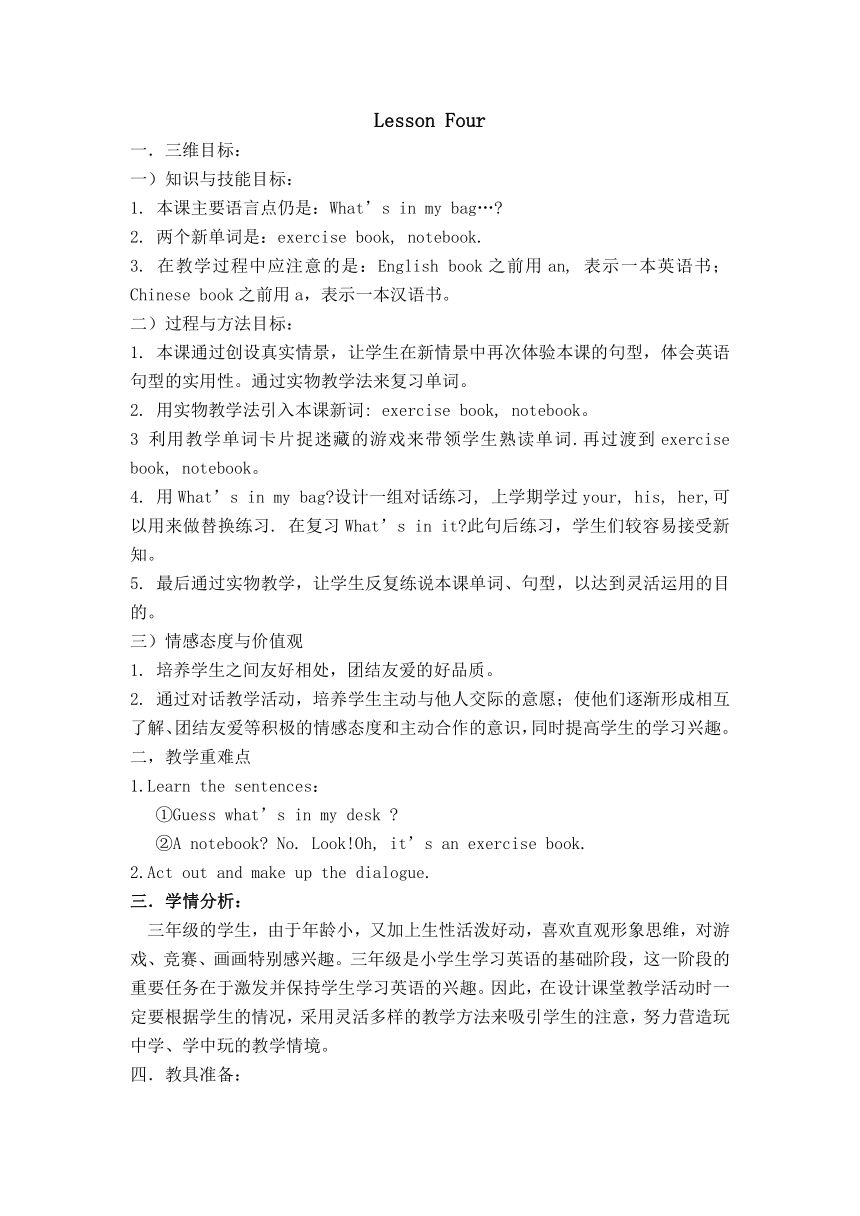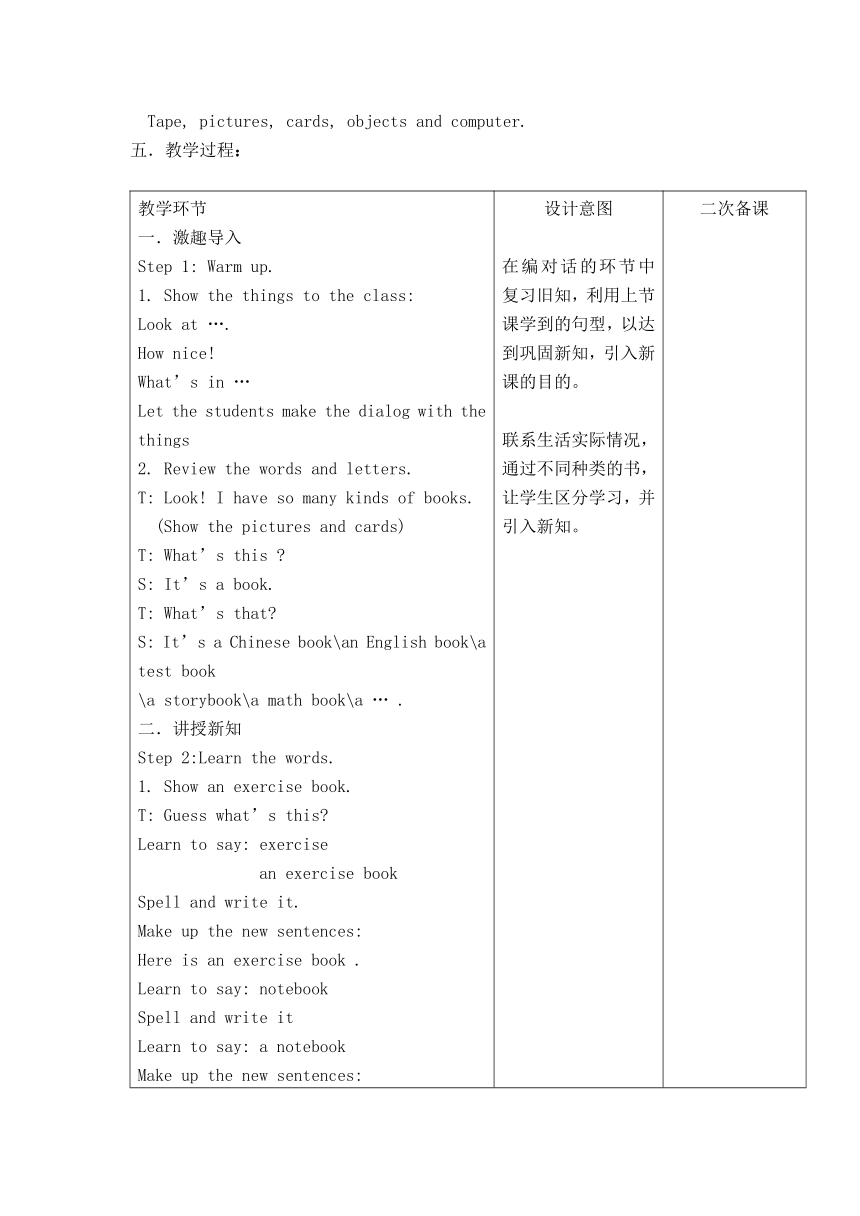Unit 1 Let’s go to school (Lesson 4) 教案
文档属性
| 名称 | Unit 1 Let’s go to school (Lesson 4) 教案 |  | |
| 格式 | docx | ||
| 文件大小 | 18.7KB | ||
| 资源类型 | 教案 | ||
| 版本资源 | 人教精通版(三年级起点) | ||
| 科目 | 英语 | ||
| 更新时间 | 2021-07-03 15:52:34 | ||
图片预览


文档简介
Lesson Four
一.三维目标:
一)知识与技能目标:
1. 本课主要语言点仍是:What’s in my bag…?
2. 两个新单词是:exercise book, notebook.
3. 在教学过程中应注意的是:English book之前用an, 表示一本英语书;Chinese book之前用a,表示一本汉语书。
二)过程与方法目标:
1. 本课通过创设真实情景,让学生在新情景中再次体验本课的句型,体会英语句型的实用性。通过实物教学法来复习单词。
2. 用实物教学法引入本课新词: exercise book, notebook。
3 利用教学单词卡片捉迷藏的游戏来带领学生熟读单词.再过渡到exercise book, notebook。
4. 用What’s in my bag?设计一组对话练习, 上学期学过your, his, her,可以用来做替换练习. 在复习What’s in it?此句后练习,学生们较容易接受新知。
5. 最后通过实物教学,让学生反复练说本课单词、句型,以达到灵活运用的目的。
三)情感态度与价值观
1. 培养学生之间友好相处,团结友爱的好品质。
2. 通过对话教学活动,培养学生主动与他人交际的意愿;使他们逐渐形成相互了解、团结友爱等积极的情感态度和主动合作的意识,同时提高学生的学习兴趣。
二,教学重难点
1.Learn the sentences:
①Guess what’s in my desk ?
②A notebook? No. Look!Oh, it’s an exercise book.
2.Act out and make up the dialogue.
三.学情分析:
三年级的学生,由于年龄小,又加上生性活泼好动,喜欢直观形象思维,对游戏、竞赛、画画特别感兴趣。三年级是小学生学习英语的基础阶段,这一阶段的重要任务在于激发并保持学生学习英语的兴趣。因此,在设计课堂教学活动时一定要根据学生的情况,采用灵活多样的教学方法来吸引学生的注意,努力营造玩中学、学中玩的教学情境。
四.教具准备:
Tape, pictures, cards, objects and computer.
五.教学过程:
教学环节
一.激趣导入
Step 1: Warm up.
1. Show the things to the class:
Look at ….
How nice!
What’s in …
Let the students make the dialog with the things
2. Review the words and letters.
T: Look! I have so many kinds of books.
(Show the pictures and cards)
T: What’s this ?
S: It’s a book.
T: What’s that?
S: It’s a Chinese book\an English book\a test book
\a storybook\a math book\a … .
二.讲授新知
Step 2:Learn the words.
Show an exercise book.
T: Guess what’s this?
Learn to say: exercise
an exercise book
Spell and write it.
Make up the new sentences:
Here is an exercise book .
Learn to say: notebook
Spell and write it
Learn to say: a notebook
Make up the new sentences:
S: Look at my….
I like it.
A notebook for you.
The teacher takes out a big bag and asks: What’s in my bag? Can you guess?
S: A Chinese book/An English book?
Let the students ask and answer each other
S1: What’s in my bag?
S2: A Chinese book/An English book
Use the students’ things and ask each other
S1: What’s in my bag/pencil-box?
S2: Some books/pencils, a crayon/ruler ….
4. Listen to the tape of lesson 4
5. Read after the lesson and guessing the meaning
6. Show the dialogues.
--Hi, Gao Wei. Guess what’s in my bag?
--Books?
--Yes. Look, a note book.
--And an exercise book.
三.巩固练习
Step 3:Game time .
Have a race:
Prepare a lot of pictures of “school things”. Ask them to watch and find.
Play the chain game:
S1: Guess what’s in my bag?
S2: A pencil-box. Guess what’s in my bag?
S3: A pencil-box, A Chinese book….
Let’s play
S1: What’s in my bag?
S2: An English book.
S3: A Chinese book.
S1: Yes.
Replace the dialogue.
Step 4:Finish the exercise book.
Introduce the ways to do the exercise book.
Teach them how to do it one step by one step.
Listen to the tape and do it
Check the answer.
四.课堂反馈
将方框内的英文填写在相应的中文后。
look at… in my classroom in the bag
an English book in my new pencil-box Look at my new pen.
在书包里
在我的教室里
3. 在我的新铅笔盒里
4. 一本英语书
5. 看…
6. 看看我的新钢笔。
五.课堂小结
作业布置:
A级:1. Make up a new dialogue in groups.
2. Write each letter and word one line
B级:Greet to the teachers warmly.
六.板书设计:
Lesson Four
What’s in my bag? An exercise book.
A notebook.
设计意图
在编对话的环节中复习旧知,利用上节课学到的句型,以达到巩固新知,引入新课的目的。
联系生活实际情况,通过不同种类的书,让学生区分学习,并引入新知。
利用游戏,接龙的方式来帮助学生进行单词和句子的综合训练。
二次备课
课后反思:
一.三维目标:
一)知识与技能目标:
1. 本课主要语言点仍是:What’s in my bag…?
2. 两个新单词是:exercise book, notebook.
3. 在教学过程中应注意的是:English book之前用an, 表示一本英语书;Chinese book之前用a,表示一本汉语书。
二)过程与方法目标:
1. 本课通过创设真实情景,让学生在新情景中再次体验本课的句型,体会英语句型的实用性。通过实物教学法来复习单词。
2. 用实物教学法引入本课新词: exercise book, notebook。
3 利用教学单词卡片捉迷藏的游戏来带领学生熟读单词.再过渡到exercise book, notebook。
4. 用What’s in my bag?设计一组对话练习, 上学期学过your, his, her,可以用来做替换练习. 在复习What’s in it?此句后练习,学生们较容易接受新知。
5. 最后通过实物教学,让学生反复练说本课单词、句型,以达到灵活运用的目的。
三)情感态度与价值观
1. 培养学生之间友好相处,团结友爱的好品质。
2. 通过对话教学活动,培养学生主动与他人交际的意愿;使他们逐渐形成相互了解、团结友爱等积极的情感态度和主动合作的意识,同时提高学生的学习兴趣。
二,教学重难点
1.Learn the sentences:
①Guess what’s in my desk ?
②A notebook? No. Look!Oh, it’s an exercise book.
2.Act out and make up the dialogue.
三.学情分析:
三年级的学生,由于年龄小,又加上生性活泼好动,喜欢直观形象思维,对游戏、竞赛、画画特别感兴趣。三年级是小学生学习英语的基础阶段,这一阶段的重要任务在于激发并保持学生学习英语的兴趣。因此,在设计课堂教学活动时一定要根据学生的情况,采用灵活多样的教学方法来吸引学生的注意,努力营造玩中学、学中玩的教学情境。
四.教具准备:
Tape, pictures, cards, objects and computer.
五.教学过程:
教学环节
一.激趣导入
Step 1: Warm up.
1. Show the things to the class:
Look at ….
How nice!
What’s in …
Let the students make the dialog with the things
2. Review the words and letters.
T: Look! I have so many kinds of books.
(Show the pictures and cards)
T: What’s this ?
S: It’s a book.
T: What’s that?
S: It’s a Chinese book\an English book\a test book
\a storybook\a math book\a … .
二.讲授新知
Step 2:Learn the words.
Show an exercise book.
T: Guess what’s this?
Learn to say: exercise
an exercise book
Spell and write it.
Make up the new sentences:
Here is an exercise book .
Learn to say: notebook
Spell and write it
Learn to say: a notebook
Make up the new sentences:
S: Look at my….
I like it.
A notebook for you.
The teacher takes out a big bag and asks: What’s in my bag? Can you guess?
S: A Chinese book/An English book?
Let the students ask and answer each other
S1: What’s in my bag?
S2: A Chinese book/An English book
Use the students’ things and ask each other
S1: What’s in my bag/pencil-box?
S2: Some books/pencils, a crayon/ruler ….
4. Listen to the tape of lesson 4
5. Read after the lesson and guessing the meaning
6. Show the dialogues.
--Hi, Gao Wei. Guess what’s in my bag?
--Books?
--Yes. Look, a note book.
--And an exercise book.
三.巩固练习
Step 3:Game time .
Have a race:
Prepare a lot of pictures of “school things”. Ask them to watch and find.
Play the chain game:
S1: Guess what’s in my bag?
S2: A pencil-box. Guess what’s in my bag?
S3: A pencil-box, A Chinese book….
Let’s play
S1: What’s in my bag?
S2: An English book.
S3: A Chinese book.
S1: Yes.
Replace the dialogue.
Step 4:Finish the exercise book.
Introduce the ways to do the exercise book.
Teach them how to do it one step by one step.
Listen to the tape and do it
Check the answer.
四.课堂反馈
将方框内的英文填写在相应的中文后。
look at… in my classroom in the bag
an English book in my new pencil-box Look at my new pen.
在书包里
在我的教室里
3. 在我的新铅笔盒里
4. 一本英语书
5. 看…
6. 看看我的新钢笔。
五.课堂小结
作业布置:
A级:1. Make up a new dialogue in groups.
2. Write each letter and word one line
B级:Greet to the teachers warmly.
六.板书设计:
Lesson Four
What’s in my bag? An exercise book.
A notebook.
设计意图
在编对话的环节中复习旧知,利用上节课学到的句型,以达到巩固新知,引入新课的目的。
联系生活实际情况,通过不同种类的书,让学生区分学习,并引入新知。
利用游戏,接龙的方式来帮助学生进行单词和句子的综合训练。
二次备课
课后反思:
同课章节目录
- Unit 1 Let's go to school.
- Lesson 1
- Lesson 2
- Lesson 3
- Lesson 4
- Lesson 5
- Lesson 6 Revision
- Unit 2 I'm in Class One, Grade Three.
- Lesson 7
- Lesson 8
- Lesson 9
- Lesson 10
- Lesson 11
- Lesson 12 Revision
- Unit 3 This is my father.
- Lesson 13
- Lesson 14
- Lesson 15
- Lesson 16
- Lesson 17
- Lesson 18 Revision
- Fun Time 1
- Recycle 1
- Recycle 2
- Project
- Unit 4 Do you like candy?
- Lesson 19
- Lesson 20
- Lesson 21
- Lesson 22
- Lesson 23
- Lesson 24 Revision
- Unit 5 It's a parrot.
- Lesson 25
- Lesson 26
- Lesson 27
- Lesson 28
- Lesson 29
- Lesson 30 Revision
- Unit 6 Is this your skirt?
- Lesson 31
- Lesson 32
- Lesson 33
- Lesson 34
- Lesson 35
- Lesson 36 Revision
- Fun Time 2
- Recycle 1
- Recycle 2
- Project
